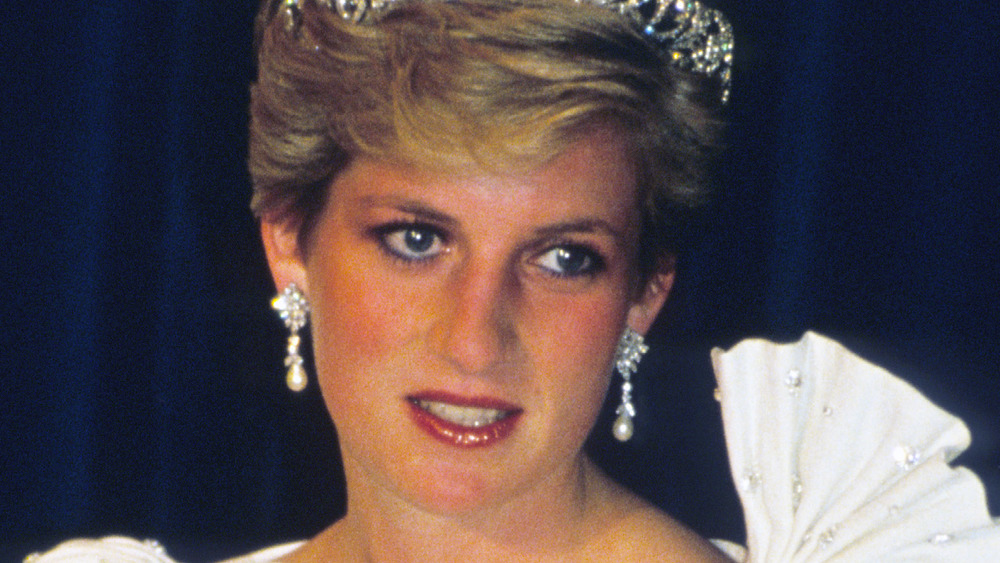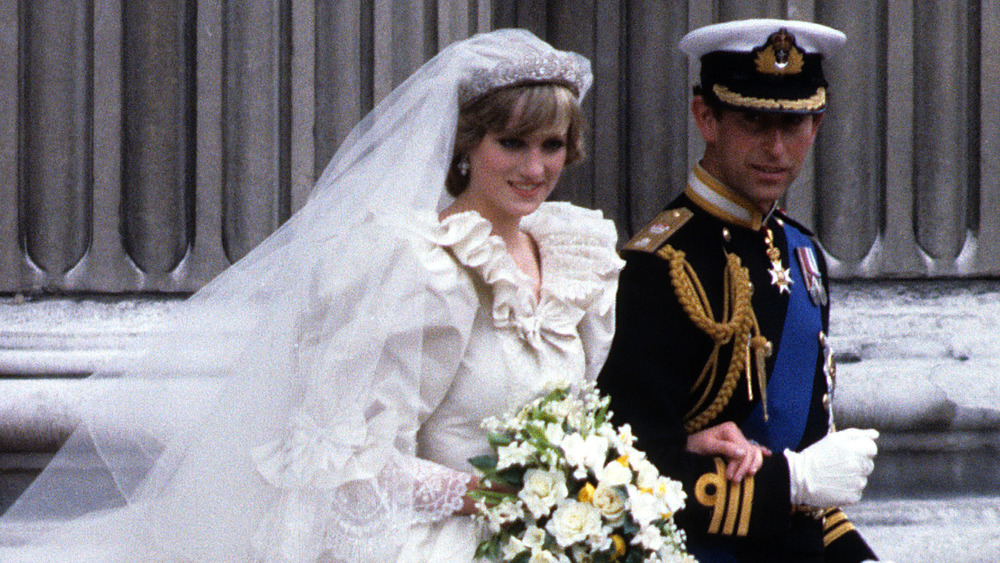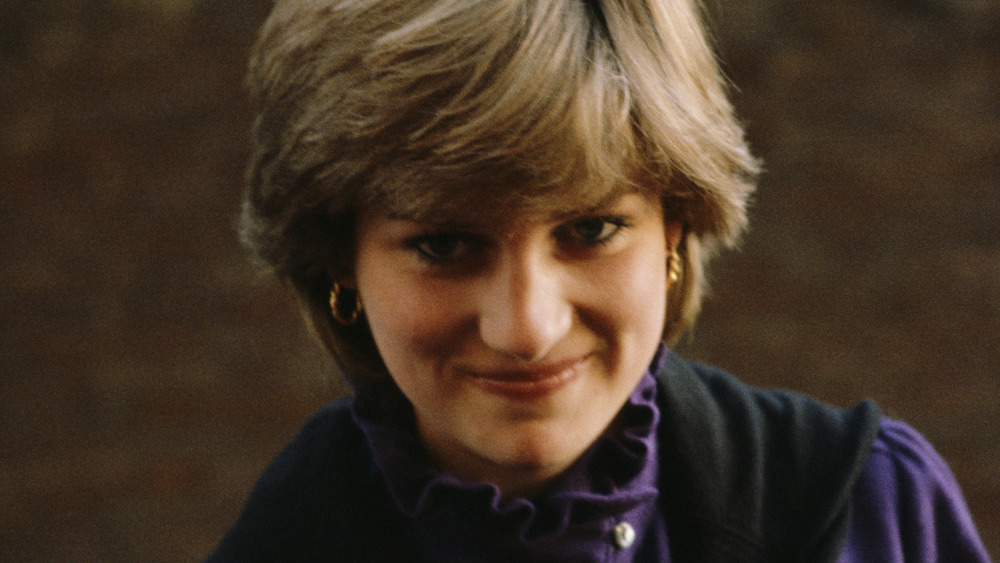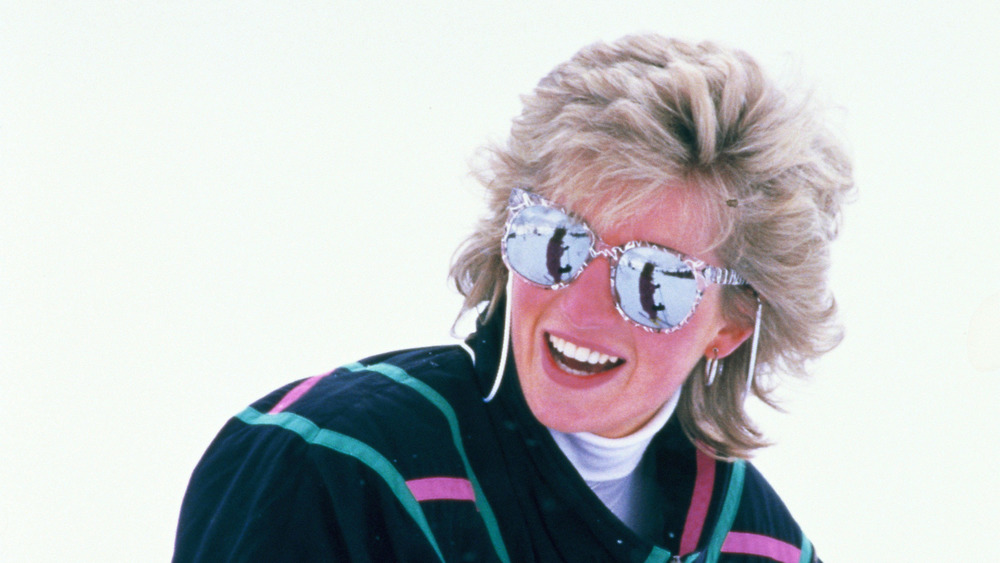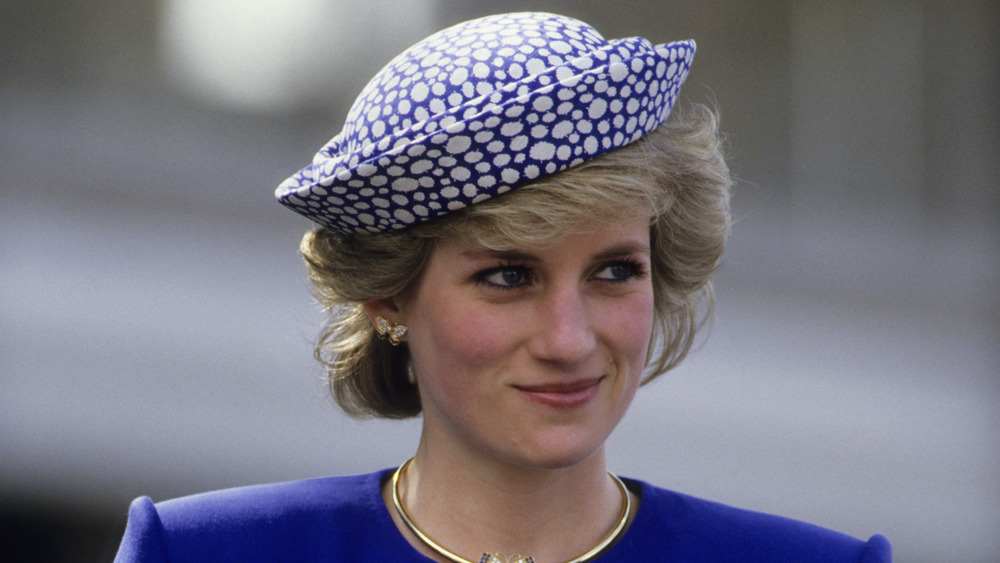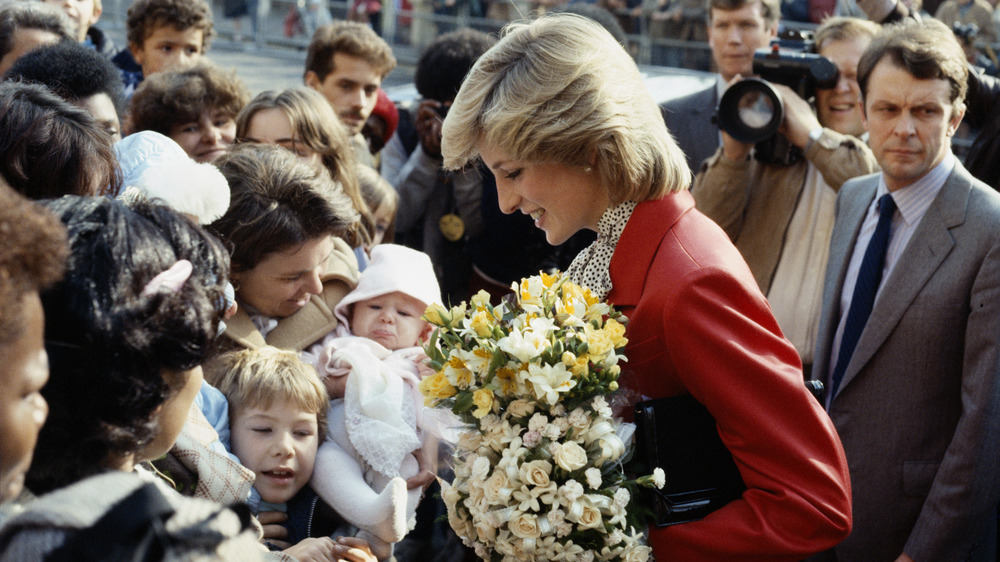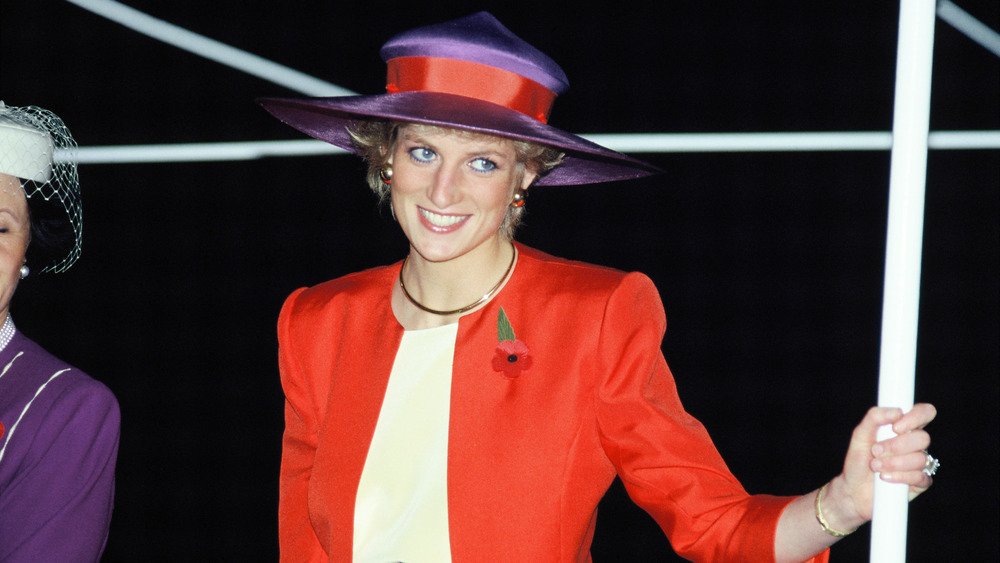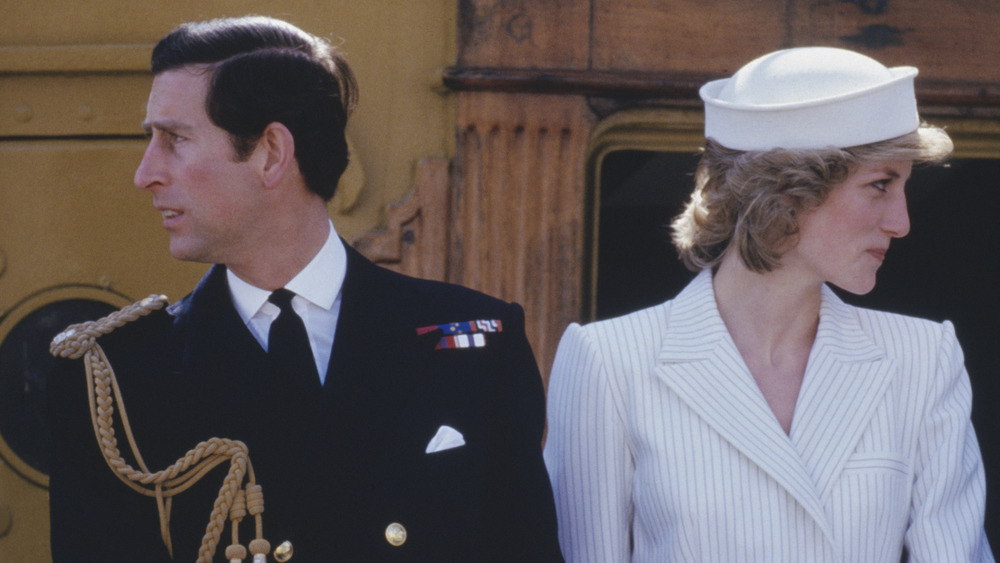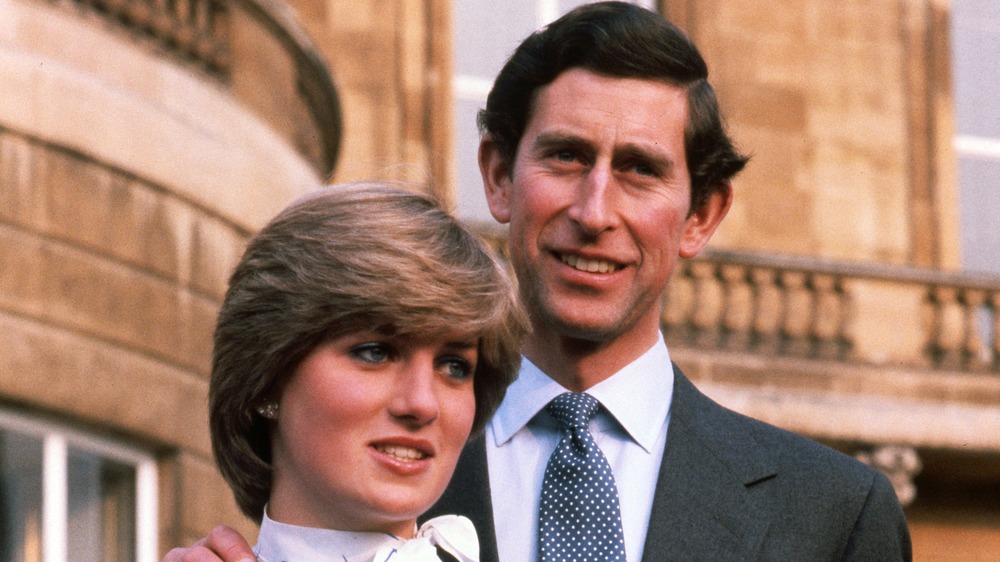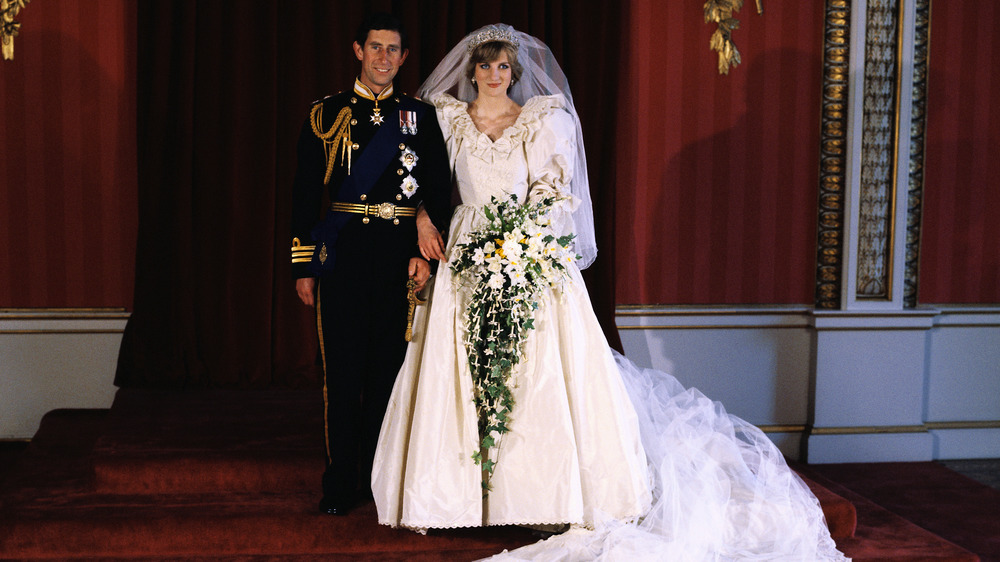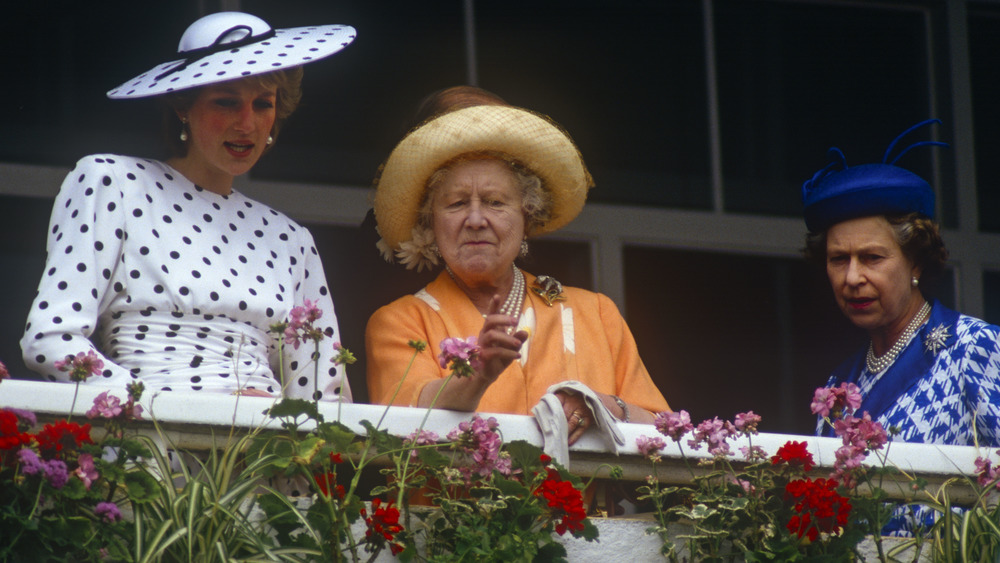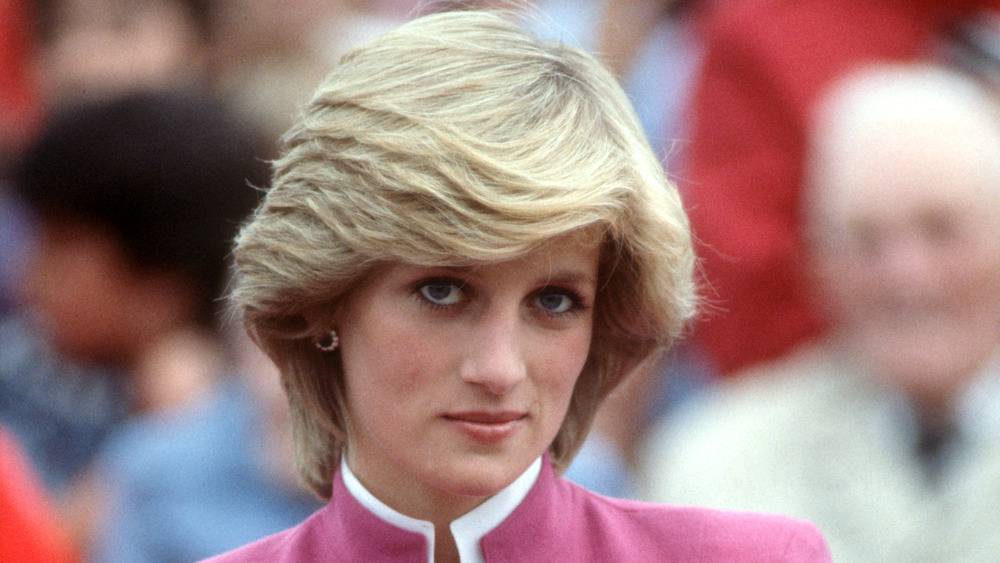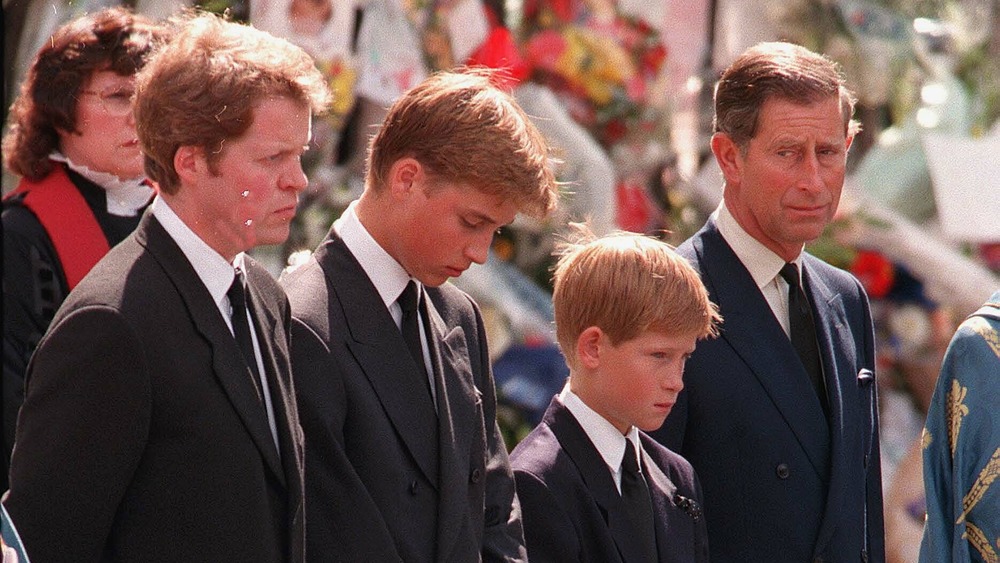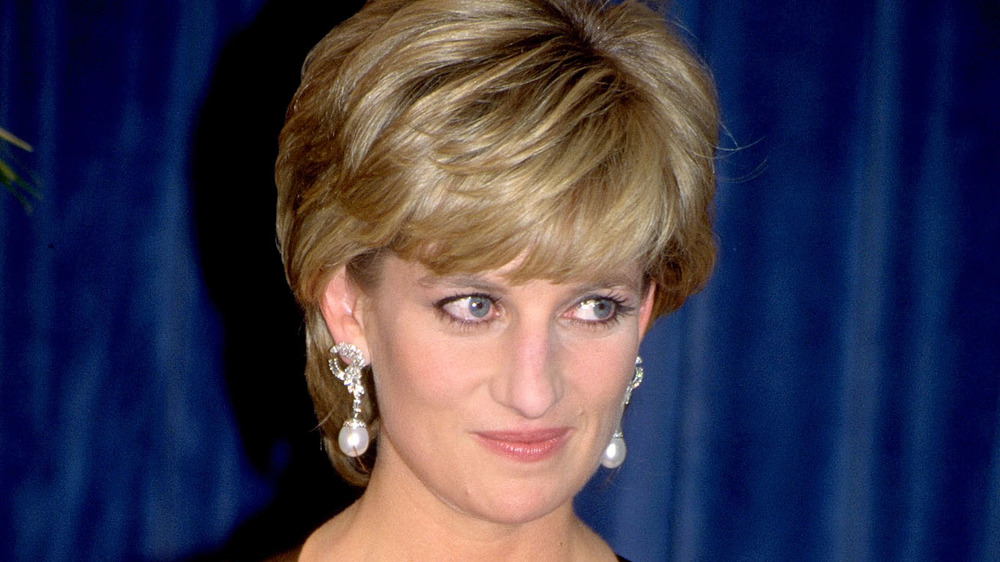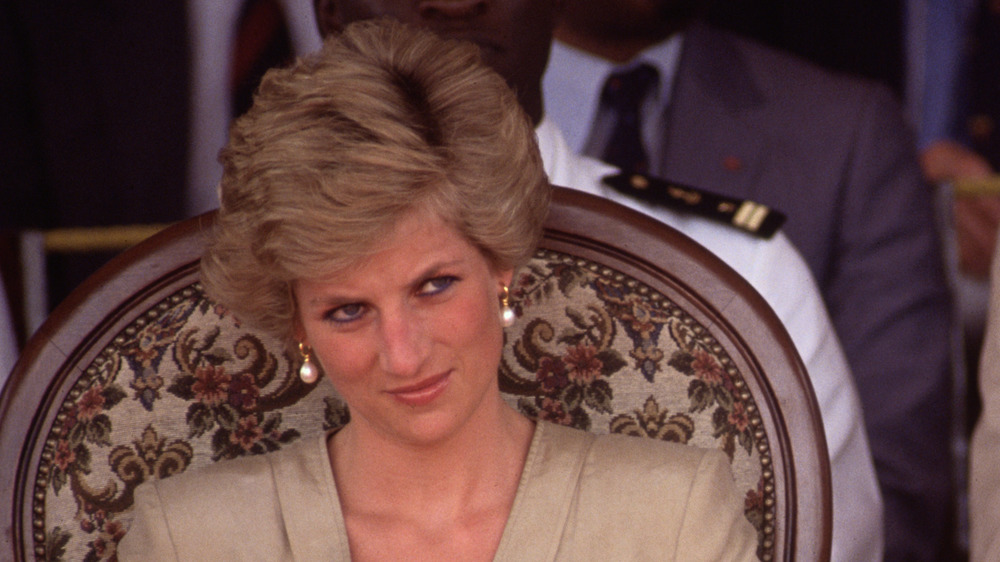False Facts About Princess Diana That Everyone Believes
Princess Diana was one of the most photographed, most recognizable, and most chronicled people of the 20th century. Yet despite that degree of fame, it's somewhat surprising that much of what people know about the so-called "People's Princess" isn't actually all that true.
Since Diana's tragic death in a horrific car wreck at age 36 in 1997, a lot of what most people think is fact has actually been overtaken by mythology — much of which Diana actually manufactured about herself. This came to be evident when Netflix debuted the fourth season of The Crown, which introduced Diana into the royal drama. After the season's November 2020 debut, the show was hit with a tsunami of backlash over fudging the truth in its depiction of Diana. Meanwhile, those who'd been watching closely realized The Crown was simply doing what it had always done: tell the factual story of Britain's royal family by using a whole of lot fictionalized dialogue and events. When it came to the story of Charles and Diana, however, people really took notice.
With that in mind, keep on reading for a look at some of the false facts about Princess Diana that everyone believes.
Technically, Diana was never a princess
One of the biggest misconceptions people have about Princess Diana is that she was, well, a princess. While she may have had the title of Princess of Wales, that doesn't actually mean she was a legitimate princess.
Complicated? Absolutely, although there is a certain royal logic behind it. As Metro pointed out, being a legit prince or princess happens at birth by being born into a royal bloodline, and only a true prince or princess can carry that title ahead of one's name. Marrying into royalty, despite what the title may imply, does not make one a princess. In fact, while "Princess Diana" is how the former Diana Spencer is best known, her actual title was Diana, Princess of Wales, the result of marrying Charles — who wasn't technically born with the title Prince of Wales, but received it at a 1969 investiture ceremony.
This is why Kate Middleton and Meghan Markle are not princesses, instead known respectively as the Duchess of Cambridge and the Duchess of Sussex thanks to their husbands' titles. After marrying Charles, Camilla Parker Bowles should have become the new Princess of Wales, noted Town & Country, but didn't — because the royals reportedly felt the title was too associated with Diana and didn't want to invite backlash.
Princess Diana was never as shy as fans assumed she was
Casting her face downward while looking up demurely, Princess Diana's image was of a shy, reluctant royal who never sought the spotlight, but simply learned to embrace it once she realized she had no choice.
This perception, said Dickie Arbiter (a.k.a. the queen's longtime press secretary), is utter nonsense. "I first met her about three or four days before the wedding. She just turned 20," Arbiter told Vogue. "People used to call her 'Shy Di,' because she kept her head down when she talked to you. But there was nothing shy about her. What she was conscious of was her height — 5-foot-10. She used to keep her head down when talking to people to not make them feel uncomfortable and to talk to them at their own level."
Diana's brother, Charles Spencer, also dismissed the "Shy Di" label. Citing the "many myths from our childhood that are just so ridiculous," he told People that his sister "was never shy, but she was canny about people and she was reserved to start with." He added, "And she would take a judgment of somebody before reacting to them. So, that's not shy... that's actually quite clever."
Princess Diana didn't always flee the paparazzi
As a think piece in the New York Post points out, Princess Diana's public image didn't just spring out of thin air — it was carefully crafted PR. While that mythology suggests that Diana was a victim of the paparazzi, her every move followed by a cadre of grubby shutterbugs, Diana's relationship with the paparazzi was sometimes symbiotic. Once she realized the paparazzi weren't going away, she figured out how to use them to her advantage. According to BBC News, that took place on several occasions, including deliberately letting herself be photographed with new beau Dodi Fayed.
She also came up with a clever way to foil the paparazzi. In the months before her death, Diana began wearing the same navy Virgin Air sweatshirt — a gift from Virgin CEO Richard Branson — every time she went to work out at London's Chelsea Harbour Club. Her presumed reasoning, noted W magazine, was if she was wearing the same outfit in every photo taken, those photos would be rendered worthless, and eventually the paparazzi would stop hounding her. The sweatshirt was eventually sold at auction in 2019 for $53,532 — far more than the original $5,000 asking price.
Her actual nickname was never Di
Princess Diana's name was so frequently shortened to "Princess Di" by the media that it would be easy to assume that was her actual nickname — but it wasn't. Speaking with Hello! magazine, her former chef, Darren McGrady, revealed that Diana's actual nickname was "Duch." As he explained, that was the nickname her family gave her because "when she was younger she always acted like a duchess." He made that discovery, he recalled, while the royal family was in Sandringham for their annual Christmas celebration.
"She came into the kitchen with Sarah Ferguson and 'Fergie' called her 'Duch.' I was surprised because I knew she was a princess and asked her why she had called her that," McGrady explained. For proof, Hello! had obtained a Christmas card signed by "Duch" and Charles.
In addition, a Daily Mail article quotes Diana's brother, Charles Spencer, referring to his sister as "Duch." In an interview with People, Spencer insisted that "Di" was merely a media invention. "First of all, none of us ever called her 'Di' at home," he declared.
Princess Diana was never really the People's Princess
Another nickname that the media bestowed upon Diana was the "People's Princess," for her down-to-earth nature and gracious ease when dealing with the common folk. And while those were indeed personality traits that served her well from a PR perspective, to say that she was "of the people" ignores reality.
Princess Diana, in fact, was raised to be an aristocrat, coming from a long line of British blue-bloods. As Wolf Hall author Hilary Mantel wrote in The Guardian, Diana may not have come from royalty, yet "her ancestors were ancient power-brokers, dug more deeply into these islands than the Windsors."
As a child, noted O, the Oprah Magazine, Diana grew up in close proximity to the royals, born in Park House, a nine-bedroom mansion situated on the grounds of the queen's Sandringham estate, where the royal family spends nearly every Christmas. "When Queen Elizabeth II and her family were staying at Sandringham, they socialized with the Spencers," added the magazine. Diana may not have been born a royal, but she was certainly raised royalty-adjacent.
Princess Diana didn't always tell the truth
When crafting a carefully constructed myth, sometimes facts that don't fit need to be altered. That certainly appeared to be the case when it came to the public persona that Princess Diana created, and insiders recalled that she often stretched the truth — occasionally to the breaking point.
"She had real difficulty telling the truth purely because she liked to embellish things," said her brother, Charles Spencer, according to an excerpt of Sally Bedell Smith's Diana in Search of Herself published in The New York Times. According to the author, Diana's friends accepted her dishonesty as simply a part of her personality.
"At least once... she lied to me outright," her friend Clive James once wrote. "She looked me straight in the eye when she said this so I could see how plausible she could be when she was telling a whopper." Another friend, Peter Palumbo, shared a similar experience. "I would ask her whether this had happened or that had happened, and she would tell me a complete lie, which I believed," he said. "But I never held it against her because that was her way, and that was her character..."
It's doubtful Diana expected Charles to be faithful in their marriage
One of Princess Diana's most famous utterances came during her infamous 1995 Panorama interview with journalist Martin Bashir. "Well, there were three of us in this marriage, so it was a bit crowded," she responded to Bashir's query about the effect Prince Charles' affair with Camilla Parker Bowles had on the breakup of her marriage.
In order to take that at face value, one must first buy into the premise that Diana actually believed she and Charles were going to be faithful. That supposition, noted BBC News, would ignore the time-honored royal tradition of monarchs taking mistresses while their wives dutifully looked the other way.
According to author Eleanor Herman, who researched the history of royal mistresses for her book Sex With Kings, these relationships weren't strictly about sex — which was certainly the case with Charles and Camilla. "Diana was beautiful but she was emotionally very needy," Herman told BBC News. "She would nag Charles, berate him and insult him and then he'd visit Camilla, who would give him wine and cheese and tell him a funny story. That was the difference." On the flip side, it's certainly not as if Diana wasn't having numerous affairs of her own.
Princess Diana wasn't shorter than Prince Charles
Judging by various photos of Prince Charles and Princess Diana together, it would easy to assume that the Prince of Wales was several inches taller than his wife. That, reported Express, was not the case; both Charles and Diana, in fact, were the same height, each standing 5-foot-10.
So how to explain all those photos in which Charles seems to be far taller than Diana? According to an article in The Sun, this was carefully devised by the Buckingham Palace PR team; to fit the fairytale that had been constructed, Prince Charming must be taller than his bride, meaning photos were meticulously staged so that Diana would appear to be shorter than her husband. To feed that myth, photos were taken of the couple on a set of stairs, with Charles one step above Diana to create the illusion of height (as seen in their engagement photos). Other tricks included Diana laying her head on Charles' shoulder, or Diana posed in a strategic slouch.
As Express reported, Diana was also reportedly banned from wearing heels when accompanying Charles on a public engagement, so as not to tower over him in public.
Princess Diana didn't adhere to traditional royal wedding vows
When Lady Diana Spencer married Prince Charles, the ceremony was televised and watched by a whopping 750 million viewers in 74 different countries, noted BBC. As people from all over the world watched in their homes, they may not have picked up on a crucial word missing when Charles and Diana exchanged vows.
That's because Princess Diana deliberately removed a single word from the traditional royal wedding vows that had been in place for generations. That word, reported The New York Times, was "obey."
While the removal of that word flew in the face of royal tradition, there were some in the British religious establishment who actually welcomed the change. ”Marriage is the kind of relationship where there should be two equal partners, and if there is going to be a dominant partner, it won't be settled by this oath,” Dr. Edward Carpenter, Dean of Westminster Abbey (where most royal weddings are held), told the Times. ”I think this is much more Christian.”
Princess Diana was far from a royal outsider
According to Princess Diana's mythology, she cleaned her sister's house and shared a flat with several roommates before being whisked away to Buckingham Palace. While that's not untrue, her family, the Spencers, are certainly not paupers, and maintain a strong historical connection to the Windsors.
The notion that Diana was suddenly thrust into the unfamiliar world of royalty is fiction. As Time recalled, a 1981 issue devoted to the wedding of Charles and Diana noted they were actually related, 16th cousins once removed. Diana, in fact, had "more English royal blood in her veins than does Prince Charles," given that she had four ancestors who were mistresses to British kings and Diana's forbears were the illegitimate children from these adulterous unions.
In the modern era, the Spencers remained tight with the royals: Diana's brother, Charles, is the queen's godson, while her father, the eighth Earl Spencer, was godson of Queen Mary and served as personal aide to both the queen and her father, King George VI. In addition, Diana's grandmother, Lady Fermoy, was lady in waiting to the Queen Mother. "There cannot be another family so stiff with royal connections," a consultant to Burke's Peerage told Time of the Spencers.
Conspiracy theories that she was murdered have been disproven
The official cause of Princess Diana's death, noted O, The Oprah Magazine, was due to injuries suffered in a car crash while driver Henri Paul was attempting to evade paparazzi chasing the vehicle. Paul and Diana's boyfriend, Dodi Fayed, also perished in the wreck.
Unofficially, however, an array of conspiracy theories have risen up that ascribe her death not to an accident, but an assassination. Fayed's father, Mohamed al-Fayed, was arguably the chief proponent of that theory, claiming Diana was pregnant with his son's child, and the royals had her killed as part of a vast conspiracy. "They murdered her!" he told a 2008 inquest, reported The New York Times.
As The Independent reported, in 2004, the British Metropolitan Police launched Operation Paget, investigating different rumors surrounding around Diana's death. When the results of the three-year, $5-million investigation were released, the report concluded Princess Diana's death was the result of a "tragic accident." The investigation ultimately found there was "no conspiracy and there was no cover-up."
Princes William and Harry didn't walk behind her coffin by choice
One of the more heartbreaking images from Princess Diana's funeral was that of sons William and Harry walking behind the carriage containing her casket. Accompanied by their father, Prince Charles, grandfather Prince Philip, and uncle Charles Spencer, the boys playing such a heartbreaking role in the midst of their unimaginable grief fed into the image of royal stoicism and stiff upper lips.
Years later, Spencer poured cold water on reports that the boys followed the casket of their own volition. In an interview with Radio 4 (via BBC News), he insisted he was a "passionate advocate" for William and Harry to not have to follow the funeral procession. However, he ultimately agreed to participate alongside them when he was told by "some courtier at Buckingham Palace" it was something the boys insisted upon doing.
He subsequently discovered he'd been "lied to and told that they wanted to do it, which of course they didn't, but I didn't realize that." In that interview, Spencer described his nephews' forced march as a "bizarre and cruel thing," and described the procession as "the most horrifying half an hour of my life."
Princess Diana was never as much of a victim as she made herself out to be
The fourth season of Netflix's The Crown depicts Princess Diana as an outsider to both the royals and her own husband. Prince Charles, in fact, is depicted as a self-pitying bully, with Diana an out-of-her-depth victim who sinks into depression, which the show implies is the result of her husband's callous treatment. That The Crown ran with that narrative isn't surprising, given that it's the same storyline that Diana herself promoted in her various media interviews. But is it accurate?
Not according to a 2017 piece in the New York Post, which pointed out that Diana worked closely with journalist Andrew Morton on the 1992 tell-all Diana: Her True Story, intuitively understanding that admitting to "bulimia and self-harm, suicide attempts and a sexless marriage" would only make the public adulation grow. At the time, however, Diana vehemently denied being the driving force behind the book, although Morton subsequently confirmed she was.
Portraying the innocent victim while lying about her involvement with the book, Morton wrote in the forward to his 2017 update Diana: Her True Story in Her Own Words, "was a part she played with aplomb."
Princess Diana didn't actually tell all in her tell-all with journalist Andrew Morton
Diana: In Her Own Words proved to be every bit the literary blockbuster that both Morton and Princess Diana hoped for, achieving both their goals: escalating Morton's profile while advancing the one-sided, self-serving narrative Diana wanted to put in front of the public.
While Diana spilled her guts about a lot of things — particularly Charles' affair with Camilla — there were things she strategically held back. Among these, reported the New York Post, was the fact that she herself had reportedly cheated "with more than one man, early and often." The Post listed them: bodyguard Barry Mannakee in 1986; car salesman James Gilbey in the late 1980s; married art dealer Oliver Hoare (who reportedly broke off the affair only to receive 300 stalker-like phone calls from Diana); rugby player Will Carling; and James Hewitt, who claimed he and Diana were involved from 1986 to 1991.
As the Post noted, when revelations of Diana's infidelity finally did leak, her popularity was hardly dented. When it came to public perception, reality proved to be no match for the myth she created.
